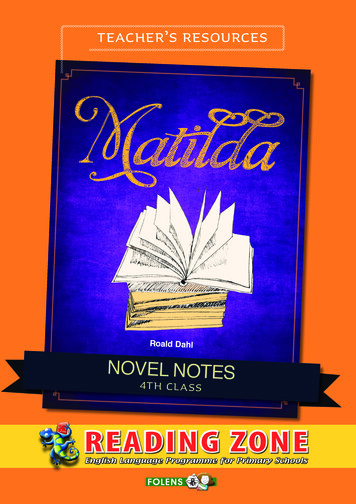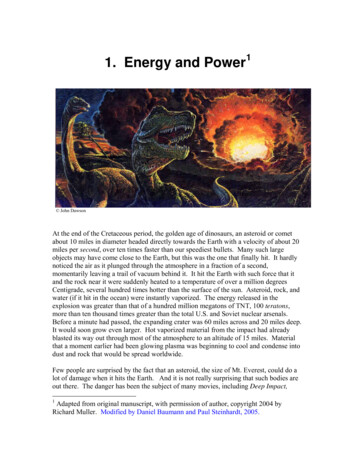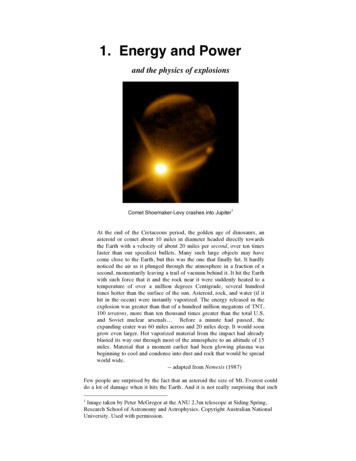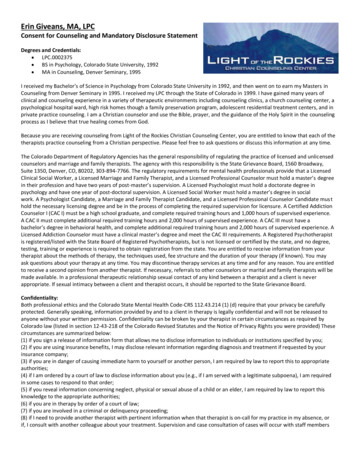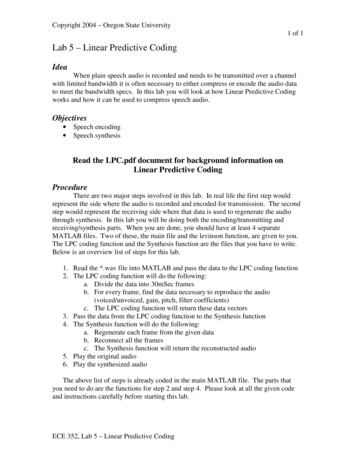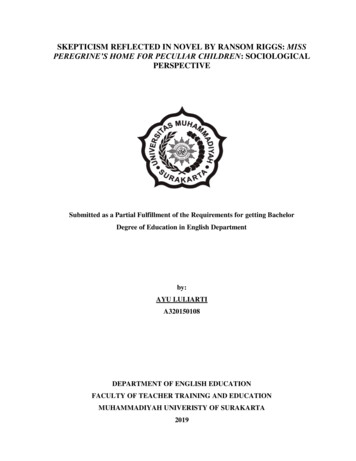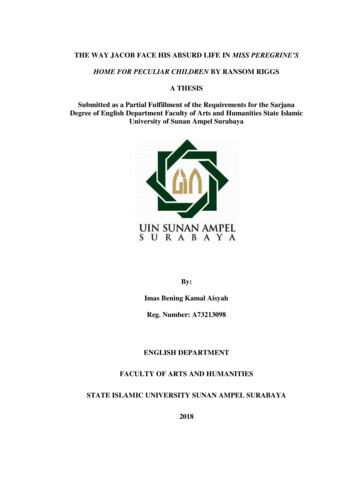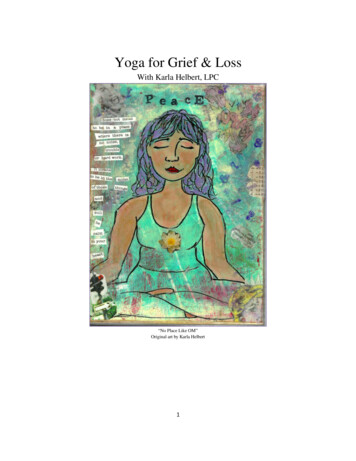
Transcription
Yoga for Grief & LossWith Karla Helbert, LPC“No Place Like OM”Original art by Karla Helbert1
Framework of the workshop Centering, Grounding, Setting intentionOM – Purnamadah Purnamidam Purnat purnamudachyate.Purnasya Purnamadaya PurnamevavashisyateOM, shanti, shanti, shanti OM – That is whole, This is whole. When a portion of the whole is removed, what remains is whole.Om, peace, peace, peace. What is yoga? Cultural perspectives v. Yogic perspectives of death, dying, grief, lossBranches of YogaHatha ‒ yoga of the physical bodyJnana — yoga of the mind, of study, of intellect, scripture, yogic texts, other enlightening text,the path of the sage or scholarBhakti — yoga of devotion, seeing the Divine, the Oneness in everythingKarma — yoga of service, of selfless acts to serve others, volunteerism, acts of kindness, the pathof self-transcending actionRaja — the “royal” path, based on the teachings of the 8 Limbs of yoga with meditation as afocal point of practice. The 8 Limbs of Yoga: the yamas (ethical standards), niyamas (selfdiscipline) asana, pranayama, pratyahara (sensory withdrawal), dhyana (meditation), samadhi(liberation)Tantra — yoga of ritual, to experience what is sacred (actually is not all about sex!), appeals tothose who enjoy ceremony and relate to the feminine principle of the cosmos, what yogis callshakti. How yoga and its philosophy moves us toward the realization of wholeness & peace The Breath: PranayamaPrana Life ForceYama Self-control, disciplineDeep Belly Breathing, 3 Part Yogic Breath, Alternate Nostril Breathing Asana: “A Steady, Comfortable Posture” Patanjali. Never a competition or comparing,even with yourself. Cultivating Acceptance. Moving to your edge ― “Comfortable discomfort.”Adapt, adjust, accommodate. Yoga Nidra or “Yogic Sleep” A conscious awareness while in a deep restful stateProgressive Muscle Relaxation, Deep Relaxation, Meditation Closing2
Why Yoga for Grief?In Sanskrit (the language of ancient India where yoga originated), the word yoga means “union.” Wecan think of this union as the connection of mind, body and spirit. The goal of yoga is to strengthenand make us aware of that connection. Side benefits include increased strength, flexibility, stressrelief, and overall improvement of major body functions (digestion, elimination, immune system,circulation, regulation of emotions and sensory processing).The Sanskrit word for the physical poses, which most people immediately associate with yoga, isasana. The word asana, which is usually interchangeable with “pose,” means “a comfortable, steadyposture.” Comfortable, so that you are not in pain, that you are not pushing yourself past yourlimitations. Steady, so that you are firm and balanced, experiencing your own strength within themoment. At a place yoga teachers often refer to as your “edge,” a place where you are experiencingstrength and challenge, keeping your mind focused on the here and now, but never inflicting harm onyourself.The essential feature which separates yoga asana from any other form of exercise, is the focus on thebreath and the mindfulness of movement combined with breath. In yoga, we return to the breathagain and again. Generally, exhaling with any contraction and inhaling as we expand. The breath isalways flowing with the movement of the body. We use the breath to help us deepen postures, as afocus point, and to energize, as well as relax the body and mind.Yoga teaches us to be present to what is, to be accepting of where we are right now, in the presentmoment. It teaches us to adjust as we need to, in order to be comfortable, yet steady; to adapt and toaccommodate in order to maintain our comfortable, steady posture as well as our peace of mind.Yoga for a grieving person addresses the needs of the body, the mind and the spirit. Along withincreasing circulation, strength, flexibility and bringing needed oxygen to the brain and bodilytissues, yoga is an excellent stress management tool. It can help us to be more spacious, to open ourhearts, even when they are breaking, and to trust that we can find ourselves stronger and steadier thanwe believed we could be.Yoga recognizes that grief is a process that demands ritual. It provides an ideal tool and a means touse ritual to manage our grief and lends itself to personalizing your own practice and ritual, weekly,daily or as needed. The very definition of yoga encourages the grieving person that he or she canconnect with something outside the pain that isolates us. This fundamental axiom of yoga gives ushope and a concrete tool to assist us in bridging felt chasms between us and our loved ones, us andSpirit, us and nature, us and others. Yoga teaches us that we are perfect and whole as we are.When a portion of this wholeness is removed, what remains is still whole and perfect. Translated from the Upanishads3
Some Suggested Yoga Asanas and Practices for the Relief and Release of Grief Mountain Pose — Tadasana. Energizes the whole body. Practicing complete stillness and fullactivity of all the major muscle groups while opening your heart, increasing breathing andstrengthening your whole body. You can do this pose anywhere, anytime. Sun Salutation — Surya Namaskar (any version you like) A flowing series of asanas combinedwith inhalation and exhalation. Energizing, strengthening, increases flexibility and circulation.Helps to perform this every day to establish a ritual and energize the body and mind, helps tocounteract feelings of depletion and sadness. Yogic Eye Movements — Helps to relieve eye strain and soreness (from crying, reading,staring at computer screens), also helps to balance both sides of the brain’s hemisphere. This canbe very helpful when processing thoughts and memories of traumatic grief (or other kinds oftrauma) over time. Cat/Cow — Strengthens and relaxes the spine. Can be done in a chair or on hands and knees.BackbendsAll back-bending postures increase flexibility and strengthen the back as well as create dynamicenergy and open the chest wall as well as the heart chakra area. Be aware that very often,backbending asanas are followed by strong emotional response in the heart and belly area. Cobra — Bhujangasana —This pose can help facilitate feelings of strength of self andopenness toward others and the world, a posture of giving and receiving without judgment. Bow Pose and Half Bow Pose — Dhanurasana & Ardha Dhanurasan — Half bow pose donefrom a hands and knees position is also a great balancing posture. Camel Pose — Ustrasana Caveat: In my experience, this posture in particular can openemotions and release painful feelings stored in the chest and heart area. Bridge Pose — Setu Bhandasana I also recommend a supported Bridge posture, using a yogablock at the sacrum. This posture “re-sets” the sacroiliac (SI) joint as well as the sympatheticnervous system, helping to facilitate a shift from stressed to calm. Hold this posture restfully forat least a minute, or longer if it’s comfortable. To come out of this pose, lift the hips, remove theblock gently and ease your lower back and hips back to the earth.4
Provide a counter pose to balance the energy created in backbends with forward bendingpostures such as Child’s Pose, Standing Forward Bend and all seated forward bends.Standing and Balancing PosesThese asanas below help to increase strength, help us to increase our balance and flexibility.There are many others, these are my favorites. Triangle — Trikonasana — Many yoga teachers say to imagine you are sandwiched betweentwo panes of glass to keep correct alignment in this pose. How many of us feel that way in grief?This pose can help us transform that feeling to one of balance and strength. Warrior I and II — Virabrahdrasana I, II, III —This pose serves to remind that you are awarrior! Feel your own power. Emotionally, this posture helps to facilitate courage and bravery.Excellent for days when we are fearful that we cannot do this. Whatever “this” is. Tree Pose — Vrksasana — Strong, beautiful, flexible, grounded, soaring—what kind of treeare you? This pose helps to create a feeling balance and harmony on all levels. King Dancer — Natarajasana — Nataraja is another name for the Hindu God Shiva thedestroyer. Paving the way for change, he is not only destruction in the natural sense but destroyerof old patterns, “stuckness. ” Without Shiva, there can be no creation of anything new. Standingin the power of Shiva’s pose, we can find the strength and grace to move with changes as well asfacilitate the ability to create change in ourselves. Eagle — Garudasana — With this posture we can help facilitate the energy of the eaglewithin, able to serenely soar above in our mind’s eagle eye; focused, far-seeing, balanced.All Spinal TwistsSpinal twists help increase spinal flexibility and relieve tension in the back and regulatedigestion. Emotionally and spiritually, twisting to the left allows us to acknowledge our past.Twisting to the right encourages us to look toward our future. Coming back to the center aftertwisting toward each side, symbolizes recognition that we are living in the present moment,honoring what is.5
InversionsAll inversions calm the brain and promote a soothing feeling that is noticeable after coming outof the pose. Hold the poses only as long as you feel comfortable. Downward Facing Dog — Adho Mukha Svanasana Classic and widely recognized, theinverted “V” pose strengthens the arms and upper back as well as uses all major muscle groups.The energy of Downward Dog is submissive and accepting, counteracting anger and aggression. Standing Forward Bend — Uttanasana Folding from standing (tadasana) at the hips, this poseencourages calmness and a deep awareness of the breath. Handstand — Adho Mukha Vrksasana Including supported handstand using the wall, this posegives an entirely different perspective to everything. The whole body is literally turned upsidedown. Calms the brain and promotes restfulness afterward. Many people feel afraid to do thispose, even with the support of the wall, but feeling afraid and doing it anyway can help us tocultivate this sense of bravery in other aspects of our lives.Restorative Poses Legs Up the Wall Pose — Viparita Karani With your bottom as close to the edge of thewall/floor as possible, support yourself with your arms and bring your feet straight up the wall.Lie back onto the floor. This pose is very helpful before bed. Relieves swelling in the feet andlegs and encourages relaxation. Emotionally, legs up the wall helps us to feel a liberated relief,that we may not have to work so hard all the time, that we can put our burdens down and acceptthat we are supported (by others, by the Universe, by our own inner peaceful Selves). Bound Angle Pose — Supta Baddha Konasana Bringing the soles of the feet together, lie backcomfortably on a pillow or bolster. If your knees are higher than your hips place pillows,bolsters, rolled up towels or yoga blocks under your knees. Also helps to facilitate emotionalrestfulness. Child’s Pose — Balasana A fetal position, big toes touching, knees as wide as comfortable,folding the upper body over the thighs with the arms where ever is most comfortable for you. Salutation Seal or Heart Seal — Anjali Mudra can be done sitting or standing, hands in prayerposition at the heart center, pressing both palms equally together, allowing a space at the centerof the palms, representing openness of the heart, mind and spirit. Mudra a symbolic handgesture or posture in yoga that is thought to “seal” certain kinds of energies within thebody/mind/spirit. There are many types of mudras. See resources section of handout.6
RelaxationCorpse Pose — Savasana Teachers say this is hardest pose of all. Allowing every single musclein our bodies to fully relax. Most yoga classes end with Savasana.Yoga Nidra (deep restfulness with conscious awareness)Breathing Exercises — Pranayama Noticing Your BreathThis is an exercise in simply noticing your breath. Becoming aware and mindful of your ownbreath as it moves in and out of your body.To begin, sit in any comfortable position, on the floor or on a chair, with your spine long andstraight but not stiff.Find a comfortable position for your hands, either folded gently in your lap, or resting on yourthighs or knees — palms up or down, whichever feels right to you.You may close your eyes if that feels comfortable. If not, find a spot on the floor a few feet infront of you and allow your gaze to soften. As you sit, begin to notice the temperature of the airon your skin, notice any sounds you may hear within or outside the room. Begin to notice yourbody’s weight as it is supported by the chair or the floor. Notice the feel of the floor or the chairunder your sitting bones, under your legs. Notice the feel of the floor beneath your feet. Expandyour awareness to noticing the sensations of your entire body without feeling the need to changeanything, simply notice.Now, begin to notice and follow the movement of your breath as it moves in and out of yourbody, as you inhale and exhale. As you inhale, notice the temperature and the vibration of the airas it flows through your nasal passages, down your throat and trachea, on its way into your lungs.Notice the different sensations of your belly, your ribs, your chest as they expand. As you exhale,notice the temperature of the air, the movement of the tiny hairs of your nose, the feeling of yourlungs empty of air as it leaves your body. Simply notice these things and any other sensationsthat occur as you continue to breathe, easily and naturally, in and out. Simply notice your breathas it moves in and out of your body without the need to change anything at all.Just Breathe.Karla Helbert, LPC 2012 All Rights Reserved7
Simple Deep BreathingSit in a comfortable position with your hands relaxed, either in your lap or resting on your thighsor knees.Relax your shoulders. Pull them up toward your ears, then roll them back and down, creatingspace between your shoulders and your ears. Allow your shoulders to relax.Breathe normally in and out for a few breaths. Notice how your belly rises and falls easily as youbreathe naturally. Your chest should not rise a great deal as you breathe in and out. If you like,you can place a hand on your abdomen to help notice the movement as you breathe in and out.When you are ready, breathe in — and on the next exhalation, breathe out slowly your nose,counting to five. During this exhalation, tighten your abdominal muscles, and pull yourdiaphragm inward, toward your spine, squeezing all the excess air out of your body. When all theair is squeezed out, pause for two counts, and inhale slowly again, to the count of five, allowingyour belly to expand as you breathe in.If you are comfortable doing so, close your eyes and continue to repeat this easy deep breath, 510 times.If you find that your mind wanders during this exercise, don’t worry. Simply bring your focusback to your breathing and begin your counts to five again.You may find it helpful to think of a happy color (such as yellow or pink) or a calming color(like blue or green) as you breathe in and a dreary color (like grey or tan) as you breathe out.You might choose to imagine breathing in a calming pleasant emotion such as peace or love asyou inhale and breathing out stress or anxiety as you exhale.As your awareness of your breath increases, it will become easier to practice your deep breathingwithout focusing so much of your attention on it.Karla Helbert, LPC 2012 All Rights Reserved8
The Three-Part BreathThe three-part breath is a specific breathing technique used in yoga practices and can be veryuseful in times of stress or whenever you need to relax. This type of breathing triggers yourparasympathetic nervous system or the “relaxation response” and allows your body and mind tomore easily release stress and tension.Practicing the three-part breath before bed can be very helpful with sleep issues — a commonproblem for bereaved people.Again find your comfortable sitting position, allowing your hands to be relaxed. The three-partbreath may also be done lying down. Practicing this breath while lying in bed before sleep is agood choice if you have difficulty clearing your mind and falling to sleep.To begin, inhale. Then, with your mouth closed, exhale slowly through your nose as you did withthe simple deep breathing exercises, using your abdominal muscles to pull your diaphragminward. Squeeze all the stale, excess air completely out of your lungs.As you prepare for your next inhalation, imagine your upper body as a large pitcher. As youinhale, you are filling the pitcher from bottom to top.First, fill the diaphragm and lower belly, allowing them to expand and completely fill with air.Next, continue to allow the pitcher to fill as you notice the lower, and then the upper, parts ofthe ribcage expanding outward and up.Next, fill the upper lungs, noticing the chest expanding, the collar bones and shoulders rising, asthe pitcher is filled completely to the top.Pause for 2 counts.Exhale in the opposite way, allowing the pitcher to empty from top to bottom.As you slowly exhale, allow the shoulders and collar bones to slowly drop, the chest to deflate,the ribs to move inward. Again pull your diaphragm in, using it to completely empty the air fromthe bottom of the lungs.Repeat the process, re-filling the pitcher slowly from bottom to top. Continue with the completeand full exhalations and inhalations, emptying and filling your pitcher.The three parts are bottom, middle, top—expanding and contracting as you slowly andcompletely fill your body with fresh, cell-nourishing, life-giving oxygen and then slowly andcompletely empty it of carbon dioxide, toxins, and tension held in the body and mind.9
As you increase your practice and the muscle movements become familiar, you may wish to addthe counting of your breaths or your color visualizations. Ideally, the exhalations should be abouttwice as long as the inhalations. Initially, if you count to 5 as you inhale and exhale, gradually tryto make your exhalations to count of 6, then 7, then 8, and so on until you feel more comfortablelengthening your exhalations.If you feel dizzy or lightheaded while practicing the three-part breath, or any other breathingexercise, stop the practice immediately and allow your breathing to go back to normal.Sometimes if we are not used to a great deal of oxygen, the change can cause lightheadedness ordizziness. Know your own body and be mindful of the changes you notice.Karla Helbert, LPC 2012 All Rights Reserved10
Other Pranayama Practices Alternate Nostril Breathing — Nadi SuddhiNadi channel through which prana flows Suddhi purification.This purpose of this breath is to purify the energetic channels in our body. Nadi Suddhi alsopromotes relief of anxiety and helps to calm the mind and body.To practice, make a Vishnu mudra with your right hand (Vishnu is the Hindu god ofpreservation). Stretching out the fingers of your right hand, fold in your index and middlefingers. You will use your extended thumb and ring fingers to alternately close off and releaseyour right and left nostrils as you practice Nadi Suddhi.Exhale fully and then inhale through both nostrils. Close off the right nostril with your thumb,and exhale through the left nostril.Keeping the right nostril closed, inhale through the left nostril. Close the left nostril with theextended ring finger, and exhale through the right nostril.Keeping the left nostril closed, inhale through the right. Close the right nostril and exhalethrough the left, inhale through the left.Close the left and exhale on the right, inhale through the right. Close the right nostril, exhalethrough the left, inhale through the left. Continue for as long as you wish. Conquerer Breath — Ujjayi PranayamaKnown for the soft hissing sound the breath makes as you direct the breath over the back of yourthroat, this breath practice helps to slow the breathing, focuses awareness and, allows for asmooth flow of breath.To practice ujjayi, exhale fully. Inahle and as you exhale, open your mouth wide and make awhispering “HAAAAA” sound, as you exhale. Repeat several times. When ready to try ujjayithrough the nose, slowly close your mouth during the “haaaaaaaa,” shifting the exhalation to thenose. This breath is also called the “unspoken mantra.”Karla Helbert, LPC 2012 All Rights Reserved11
Meditation practices — DhyanaMeditation is helpful for reduction of stress and anxiety and can help us to become more awareof the messages we send ourselves. This practice will help you learn to become more aware ofhow many thoughts come into your mind at any given moment, and to become more adept atnoticing them when they come at points throughout your day, when you aren’t engaged inpracticing meditation. Over time, this practice can help you become better at not gettinginvolved, or hooked into, every thoughts that might come at any given moment.There are many different meditation techniques and none is necessarily better than the others, itdepends on individual preference. Because the breath is always there with you, I suggest usingthe breath as a returning point. I suggest labeling the thoughts as they come because it helps us tonotice them more easily when they come during non-meditation time, and also because labelingthe thoughts help us break self-identification with our thoughts. You are not your thoughts andyou don’t have to believe everything you think. You can control how and what you think.I suggest starting with a small goal of 2 minutes a day and work up slowly, adding a minute on toyour time weekly. Use a timer so that you don’t feel compelled to check the clock.Turn off your phone and other technological devices that could interrupt you. Find a comfortablespot—you can sit in a chair or on the floor. If you sit on the floor, you might want to use a pillowto sit on. If you choose to sit in a chair, let your feet be flat on the floor. Allow your hands to restin your lap on or your knees in a comfortable position. Allow your spine to be long and tall, butnot stiff. Roll your neck from side to side to release tension. Using the three-part breath, take afew deep, cleansing breaths deep into your belly. Allow your breathing to return to normal.Then, simply begin to notice. Notice how the floor feels beneath your feet. Notice the feeling ofyour body at the points where it rests either on the floor or against the chair, how your clothesfeel on your body. Notice the feeling of the material of your clothing against your skin. Noticewhether you feel any tension in any area of your body. Simply notice. Begin to notice thetemperature of the air, notice how it feels on the parts of your body that are uncovered. Youdon’t have to do anything to change, just notice. Begin to notice the sounds that you hear aroundyou; in the room, outside the room. Just noticing. Notice any sounds you may become aware ofwithin your own body—again, not having to change anything, simply noticing. Begin to bringyour awareness to your breath. Notice how it feels as it moves in and out of your body, notchanging anything, just being with what is and noticing. Allow your attention to remain withyour breath, in and out, notice the temperature of the air as it enters your nose, moves down yourtrachea and into your lungs. Notice that it is warmer and more moist as it gently leaves yourbody. Notice the movements of your abdomen, your ribs and your chest as your breath moves inand out of your body. Just breathing and noticing.12
Continue to simply stay with your breath. If you wish, you can count your breaths, in and out, 1,in and out 2, and so on to ten and then return to 1. You might want to use color visualizationswith your breath—imagine breathing in a color that you associate with a feeling state you wouldlike to achieve, such as peace or calm, and then breathing out a color you associate with a feelingyou would like to be rid of—fear, stress, anxiety, etc. You might want to use a mantra with yourin/out breaths. On an in breath thinking, “I am .” on an out breath, “calm.” Some otherexamples might be:In breath: “All is ”Out breath: “well.”In breath: “I am ”Out breath: “Loved.”You get the idea. Come up with whatever works for you to help you stay with your breath.Eventually, you will notice you are no longer aware of your breath and instead, you are thinkingabout something else. This is ok, and it will happen. When you notice a thought (or an emotion),simply label it and then bring your attention back to your breath. You don’t have to get involvedor take the thought or feeling to the next place it might go. Simply label it and come back toyour breath, knowing that if you really want to think or feel that thing, it will be there when youare finished with your practice for the day.Label your thoughts and emotions with what they are: thinking, worrying, planning, doubting,judging, fantasizing, anxiety, fear, impatience, irritation, etc. And then bring your attention backto your breath. “I’m thinking” come back to the breath “I’m planning” come back to thebreath “Anxiety” come back to the breath “Judging” come back to the breath.Continue in this way until your time is completed for the day’s practice.After your timer goes off, take a moment to notice how you are feeling. Take a couple of deepbreaths and go on with your day.Karla Helbert, LPC 2012 All Rights Reserved13
A Short Yoga Flow to Help With Stress & TensionBegin on the floor on your knees, sitting back on your heelsBring your hands to your heart center (Namaste)Take 3-4 cleansing breathsInhale arms up to “standing” on your knees, arms reaching upwardExhale into Child’s PoseCome to a table top position (hands and knees, neck neutral)Inhale CowExhale into Downward Facing DogInhale back to Cow poseExhale to Child's PoseInhale up to knees, arms reaching upwardExhale back onto your heelsRepeat 2-3 times as desiredHands return to Namaste at the end of your flow(Knees, child, cow, dog, cow, child, knees)14
The Wholeness of Griefby Karla Helbert, LPCWhen he was three months old, my firstborn child was diagnosed with a choroid plexuscarcinoma, a rare, aggressive brain tumor that grows on the structure inside the brain that makescerebral spinal fluid. Two weeks after the initial resection of the tumor, and two more subsequentsurgeries to drain fluid from his brain, he endured his first chemotherapy treatment. Three daysfollowing the administration of the chemo, a CT scan revealed that his brain was completelydestroyed. The scan showed no healthy tissue. Doctors called it “total neurological devastation.”If somehow, after 70 weeks of chemotherapy, more surgery and radiation treatment, he were todefy all odds and survive the tumor, the neurological devastation would ensure that my sonwould have very little, if any, independent functioning. The likelihood of survival was minimal.We didn’t want him to endure any more suffering caused by chemotherapy or excessivesurgeries. We chose to discontinue treatment of the tumor and bring him home to love him, takecare of him and make him as comfortable as possible. Exactly six months after the diagnosis, mybeautiful baby boy died at home with his father and me, our arms enfolding him. During thosemonths and after, we endured grief upon grief. We experienced intense pain, sadness, and fear,but there were also beautiful moments spent with him, peaceful and sacred times. I feelincredibly fortunate to have been granted those months with him, to have experienced the joyand wonder of his arrival in this world and to have had the deep honor of being there with him ashe left. The pain and sadness are still with me. Along with all the rest of who I am, I will alwaysbe a bereaved mother. I have learned, though, that one can travel from the dark depths of griefinto a place of warmth and light, where it is possible not only to survive the pain, but to thrive.During times of great grief, we look for anything that can bring any small comfort. Among otherthings, I am also a student of yoga, which was been a source of peace to me in some very darktimes. One of my favorite yoga practices is that of chant—the repetition of a mantra—wordsrepeated over and over, to calm the mind and lift the spirit. One of my most beloved chants is averse from the Upanishads, sacred texts written thousands of years ago in the Sanskrit language.Some revered teachers have said that if all other verses from all sacred texts were lost, they couldall be re-born and re-written from this one verse, known as the purnamidah. These are the words:OM, purnamadah purnamidam purnaat purnamudachyatepurnasya purnaamadaya purnameva vashishyateShanti, Shanti, ShantiThe verse is translated to mean:This is whole and complete, that is whole and complete. This and that are whole andcomplete. From wholeness comes wholeness. When a portion of wholeness is removed,that which remains continues to be whole and complete.Peace, Peace, Peace.The message of the purnamidah is that wholeness, fullness and completeness enfolds us all. Allbeings, souls, things, objects, planets, trees, stars, rocks, animals, all energy and all matter arepart of the wholeness. Nothing can be separated from that wholeness or completeness. In this15
belief, there is no death, no separation. The notion of separateness is false. All is One. A little bitof what is whole and complete cannot be broken or taken away from that essential wholeness.I chanted the purnamidah, which I learned in a yoga workshop years before, to my pregnantbelly. I sung it as a lullaby to my son after his birth, during his illness, and also after he died. Iknew the translation of the chant, but had never really given it much deep thought. One night,about a month after his funeral, deep in grief, I was soaking in the tub, which I often did. Hottears mixing wi
Tantra — yoga of ritual, to experience what is sacred (actually is not all about sex!), . The essential feature which separates yoga asana from any other form of exercise, is the focus on the breath and the mindfulness of movement combined with breath. In yoga, we return to the breath . Yoga


